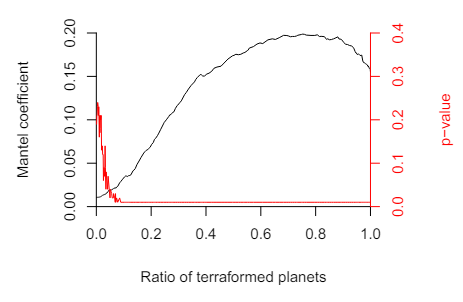Table of Links
2. Methods
2.1. Modeling Panspermia and Terraformation
2.2. Identifying the Presence of Terraformed Planets and 2.3. Software and Availability
3. Results
3.1. Panspermia can increase the correlation between planets’ compositions and positions
3.2. Likely terraformed planets can be identified from clustering
5. Acknowledgements and References
APPENDIX
3.1. Panspermia can increase the correlation between planets’ compositions and positions
We find that panspermia causes uncorrelated planets to become positively correlated in position-composition distance space, as quantified by the Mantel test (see Methods. 2.2.2).
We initialized a simulation with the intention of making terraformation easy and reliable, in order to check if a positive Mantel correlation coefficient was observable in a “best case” scenario. The simulation begins with a single terraformed planet, targets the most compositionally similar planet within Rpos ≤ 20 (≈ 11% of the maximum possible distance between planets in our model), and with terraformation keeping 1 of the 10 compositional elements from the pre-terraformed planet. This means that over time, all planets in the simulation acquire similar, but not identical compositions. We found that the Mantel coefficient indeed increased as the ratio of terraformed planets increased, until reaching a peak around a terraformed ratio of ≈ 0.75, and then decreased (Fig. 2, black). Because the Mantel coefficient is measuring the correlation between positional and compositional distance matrices of planets, this correlation will decrease if either distance matrix becomes too homogeneous. This is exactly what begins to happen with the compositional distance matrix, with the decline especially pronounced if there is perfect replication (see Appendix Fig. A1, and Appendix Sec. A for a discussion on the effect of varying simulation parameters).

While the increase in Mantel correlation coefficient we can observe is striking, what we are really interested in is how anomalous the observed correlations in position/composition space are, and not the absolute value of them. That is, we expect life spreading via panspermia and terraformation to cause not just positive mantel correlation coefficients, but anomalously high ones compared to other possible permutations of the data. As seen in Fig. 2 (in red), the p-value of our Mantel test indeed decreases as planets become terraformed, and after ≈ 8% of planets are terraformed, p ≤ 0.01 (which is the maximal precision we can reach with 99 permutations).
Based on our postulates, this indicates that the Mantel test—and more specifically its p-value (which remains low even after the coefficient decreases)—can identify the presence of panspermia and terraformation, provided there are enough planets in our observed population terraformed. When we investigated how sensitive the mantel coefficient is to number of planets observed (independent of the number terraformed), we find that the value of the mantel coefficient corresponding to a similarly confident 2.5σ detection increases exponentially with fewer planets observed (i.e., to reach the same confidence with fewer observations, we need a higher Mantel coefficient. See Fig. A3).
But even if we live at a point in time where there actually are ≥ 10% of planets terraformed, this does not answer the question of which planets observed within our population might host life. Identifying such planets would be important for determining targets for follow up detailed observations, in the event that the methodology adhered to with these model results could be carried out with a simpler set of observational data.
Authors:
(1) Harrison B. Smith, Earth-Life Science Institute, Tokyo Institute of Technology, Ookayama, Meguro-ku, Tokyo, Japan, and Blue Marble Space Institute of Science, Seattle, Washington, USA ([email protected]);
(2) Lana Sinapayen, Sony Computer Science Laboratories, Kyoto, Japan and National Institute for Basic Biology, Okazaki, Japan ([email protected]).
This paper is
